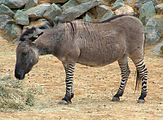
Hybrid (biology)
In biology, a hybrid is the offspring resulting from combining the qualities of two organisms of different varieties, species or genera through sexual reproduction. Generally, it means that each cell has genetic material from two different organisms, whereas an individual where some cells are derived from a different organism is called a chimera.[1] Hybrids are not always intermediates between their parents such as in blending inheritance (a now discredited theory in modern genetics by particulate inheritance), but can show hybrid vigor, sometimes growing larger or taller than either parent. The concept of a hybrid is interpreted differently in animal and plant breeding, where there is interest in the individual parentage. In genetics, attention is focused on the numbers of chromosomes. In taxonomy, a key question is how closely related the parent species are.
Species are reproductively isolated by strong barriers to hybridization, which include genetic and morphological differences, differing times of fertility, mating behaviors and cues, and physiological rejection of sperm cells or the developing embryo. Some act before fertilization and others after it. Similar barriers exist in plants, with differences in flowering times, pollen vectors, inhibition of pollen tube growth, somatoplastic sterility, cytoplasmic-genic male sterility and the structure of the chromosomes. A few animal species and many plant species, however, are the result of hybrid speciation, including important crop plants such as wheat, where the number of chromosomes has been doubled.
Human impact on the environment has resulted in an increase in the interbreeding between regional species, and the proliferation of introduced species worldwide has also resulted in an increase in hybridization. This genetic mixing may threaten many species with extinction, while genetic erosion from monoculture in crop plants may be damaging the gene pools of many species for future breeding. A form of often intentional human-mediated hybridization is the crossing of wild and domesticated species. This is common in both traditional horticulture and modern agriculture; many commercially useful fruits, flowers, garden herbs, and trees have been produced by hybridization. One such flower, Oenothera lamarckiana, was central to early genetics research into mutationism and polyploidy. It is also more occasionally done in the livestock and pet trades; some well-known wild × domestic hybrids are beefalo and wolfdogs. Human selective breeding of domesticated animals and plants has resulted in the development of distinct breeds (usually called cultivars in reference to plants); crossbreeds between them (without any wild stock) are sometimes also imprecisely referred to as "hybrids".
Hybrid humans existed in prehistory. For example, Neanderthals and anatomically modern humans are thought to have interbred as recently as 40,000 years ago.
Mythological hybrids appear in human culture in forms as diverse as the Minotaur, blends of animals, humans and mythical beasts such as centaurs and sphinxes, and the Nephilim of the Biblical apocrypha described as the wicked sons of fallen angels and attractive women.
As seen by different disciplines[edit]
Animal and plant breeding[edit]
From the point of view of animal and plant breeders, there are several kinds of hybrid formed from crosses within a species, such as between different breeds.[4] Single cross hybrids result from the cross between two true-breeding organisms which produces an F1 hybrid (first filial generation). The cross between two different homozygous lines produces an F1 hybrid that is heterozygous; having two alleles, one contributed by each parent and typically one is dominant and the other recessive. Typically, the F1 generation is also phenotypically homogeneous, producing offspring that are all similar to each other.[5]
Double cross hybrids result from the cross between two different F1 hybrids (i.e., there are four unrelated grandparents).[6]
Three-way cross hybrids result from the cross between an F1 hybrid and an inbred line. Triple cross hybrids result from the crossing of two different three-way cross hybrids.[7] Top cross (or "topcross") hybrids result from the crossing of a top quality or pure-bred male and a lower quality female, intended to improve the quality of the offspring, on average.[8]
Population hybrids result from the crossing of plants or animals in one population with those of another population. These include interspecific hybrids or crosses between different breeds.[9] In biology, the result of crossing of two populations is called a synthetic population.[10]
In horticulture, the term stable hybrid is used to describe an annual plant that, if grown and bred in a small monoculture free of external pollen (e.g., an air-filtered greenhouse) produces offspring that are "true to type" with respect to phenotype; i.e., a true-breeding organism.[11]
Human influence[edit]
Anthropogenic hybridization[edit]
Hybridization is greatly influenced by human impact on the environment,[50] through effects such as habitat fragmentation and species introductions.[51] Such impacts make it difficult to conserve the genetics of populations undergoing introgressive hybridization. Humans have introduced species worldwide to environments for a long time, both intentionally for purposes such as biological control, and unintentionally, as with accidental escapes of individuals. Introductions can drastically affect populations, including through hybridization.[14][52]


